Ever feel like grasping the possible? For many years, breaking the 4 minute-mile in track and field was thought to be impossible. And then one day in June 1954, Roger Bannister, an Australian, broke the 4-minute mile with a time of 3 minutes, 59.4 seconds. The recognition of the possibility of this feat resulted in 10 other runners breaking this barrier within one year of Bannister’s triumph. In other words, the myth of its impossibility held runners back and the reality of its possibility yielded numerous breakthroughs.
I want to help you believe that resilience and optimal functioning are possible. I want to show you that “The Path” will take you there and, most importantly, that it’s within your grasp.
Change involves a very basic yet difficult-to-achieve force. When I first began presenting seminars 30 years ago, I was excited about teaching people what they could do to reduce their stress, handle it better and live a better life. Participants of my seminars and workshops attended because they were challenged and even overwhelmed by the demands of their lives and the symptoms they were experiencing. Yet, after listening to my program and leaving with enthusiasm about following through, six months down the road, they had fallen back into their old patterns.
Despite experiencing the consequences of too much stress, many people resist doing anything about it. Change is difficult, after all, no matter how motivated you are. This ordinarily difficult process is exacerbated by our specific resistance to dealing with stress and changing our habitual patterns. For the past 25 years, I have been researching and experimenting with ways to address one of the most primal forces known to humankind. I have described this force as each person’s Primitive Gestalt. It carries with it a gravitational pull, holding behaviors and thinking in place.
Primitive Gestalts are the neurobiobehavioral patterns established as the result of early survival learning. Briefly, Primitive Gestalts (PG) are conceptualized as fixed patterns in the brain, and they exert a gravitational force on all our behaviors, perceptions, and thinking. This gravitational force makes fundamental change as difficult as it is for a spaceship to leave the earth’s gravitational pull, or an electron to leave its orbit around the nucleus of the atom.
We can say that at the heart of Resilient Success is the ability to shift one’s pattern and not be stuck in rigid thinking and behaving, and excess emotional reactivity. Thus part of the process is to help you loosen the hold that your PG has on you—to block its “attractor state” quality and even to show you how it’s no longer needed. Part of this process involves labeling some of your old thinking as “harmful.”
Dr. Stephen Sideroff is an internationally recognized expert in resilience, optimal performance, addiction, neurofeedback and alternative approaches to stress and mental health. He is Assistant Professor in the Department of Psychiatry & Biobehavioral Sciences at UCLA’s School of Medicine, as well as the Director of the Raoul Wallenberg Institute of Ethics. www.drstephensideroff.com


